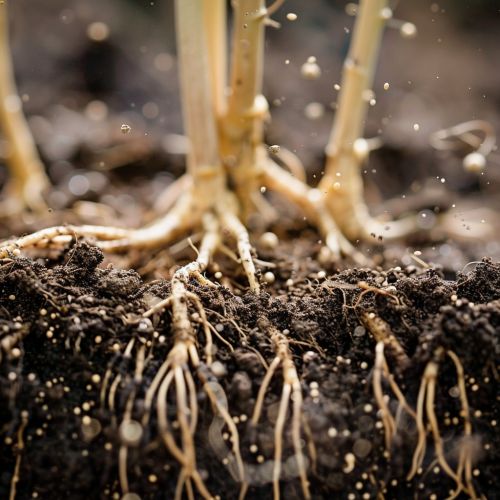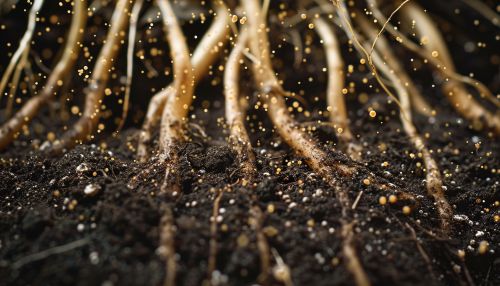Plant microbiome: Difference between revisions
(Created page with "== Introduction == The **plant microbiome** refers to the community of microorganisms, including bacteria, fungi, archaea, viruses, and protists, that live in association with plants. These microorganisms inhabit various plant compartments such as the rhizosphere (root-associated soil), phyllosphere (above-ground parts), endosphere (internal tissues), and spermosphere (seed-associated). The plant microbiome plays a crucial role in plant health, growth, and development b...") |
No edit summary |
||
| (One intermediate revision by the same user not shown) | |||
| Line 9: | Line 9: | ||
The rhizosphere is the narrow region of soil directly influenced by root secretions and associated soil microorganisms. It is one of the most dynamic environments in the plant microbiome. The rhizosphere microbiome includes a diverse array of bacteria, fungi, and archaea. Key bacterial genera such as [[Pseudomonas]], [[Bacillus]], and [[Rhizobium]] are commonly found in the rhizosphere due to their abilities to promote plant growth and suppress pathogens. | The rhizosphere is the narrow region of soil directly influenced by root secretions and associated soil microorganisms. It is one of the most dynamic environments in the plant microbiome. The rhizosphere microbiome includes a diverse array of bacteria, fungi, and archaea. Key bacterial genera such as [[Pseudomonas]], [[Bacillus]], and [[Rhizobium]] are commonly found in the rhizosphere due to their abilities to promote plant growth and suppress pathogens. | ||
[[Image:Detail-93329.jpg|thumb|center|Close-up of plant roots with soil particles and visible microorganisms.|class=only_on_mobile]] | |||
[[Image:Detail-93330.jpg|thumb|center|Close-up of plant roots with soil particles and visible microorganisms.|class=only_on_desktop]] | |||
=== Phyllosphere === | === Phyllosphere === | ||
Latest revision as of 09:29, 22 June 2024
Introduction
The **plant microbiome** refers to the community of microorganisms, including bacteria, fungi, archaea, viruses, and protists, that live in association with plants. These microorganisms inhabit various plant compartments such as the rhizosphere (root-associated soil), phyllosphere (above-ground parts), endosphere (internal tissues), and spermosphere (seed-associated). The plant microbiome plays a crucial role in plant health, growth, and development by influencing nutrient acquisition, disease resistance, and stress tolerance.
Composition of the Plant Microbiome
Rhizosphere
The rhizosphere is the narrow region of soil directly influenced by root secretions and associated soil microorganisms. It is one of the most dynamic environments in the plant microbiome. The rhizosphere microbiome includes a diverse array of bacteria, fungi, and archaea. Key bacterial genera such as Pseudomonas, Bacillus, and Rhizobium are commonly found in the rhizosphere due to their abilities to promote plant growth and suppress pathogens.


Phyllosphere
The phyllosphere encompasses the above-ground parts of plants, including leaves, stems, and flowers. This environment is exposed to fluctuating environmental conditions such as UV radiation, temperature, and humidity. Despite these challenges, the phyllosphere hosts a variety of microorganisms, predominantly bacteria and fungi. Genera such as Methylobacterium, Sphingomonas, and Cladosporium are frequently isolated from the phyllosphere.
Endosphere
The endosphere consists of the internal tissues of plants, including roots, stems, and leaves. Endophytic microorganisms live within plant tissues without causing harm. They can provide various benefits to the host plant, such as enhancing nutrient uptake and producing phytohormones. Common endophytic bacteria include Burkholderia, Enterobacter, and Streptomyces, while endophytic fungi often belong to the genera Fusarium and Trichoderma.
Spermosphere
The spermosphere is the microenvironment surrounding seeds. This niche is critical during seed germination and early seedling development. Microorganisms in the spermosphere can influence seed germination rates and seedling vigor. Bacterial genera such as Pseudomonas and Bacillus are prevalent in the spermosphere, often due to their ability to produce plant growth-promoting substances.
Functions of the Plant Microbiome
Nutrient Acquisition
Microorganisms in the plant microbiome play a vital role in nutrient cycling and acquisition. For example, nitrogen-fixing bacteria such as Rhizobium form symbiotic relationships with leguminous plants, converting atmospheric nitrogen into a form usable by plants. Mycorrhizal fungi enhance phosphorus uptake by extending the root surface area through their hyphal networks.
Disease Suppression
The plant microbiome contributes to disease suppression through various mechanisms, including competition for nutrients and niches, production of antimicrobial compounds, and induction of plant defense responses. Beneficial microbes such as Trichoderma and Pseudomonas are known for their biocontrol properties against plant pathogens.
Stress Tolerance
Microorganisms can enhance plant tolerance to abiotic stresses such as drought, salinity, and heavy metal toxicity. For instance, certain endophytic bacteria produce exopolysaccharides that help plants retain water under drought conditions. Additionally, some microbes can detoxify heavy metals, reducing their phytotoxic effects.
Plant-Microbe Interactions
Symbiotic Relationships
Symbiotic relationships are mutually beneficial interactions between plants and microorganisms. Examples include the association between leguminous plants and nitrogen-fixing Rhizobium bacteria, and the mycorrhizal symbiosis between plants and fungi. These interactions are essential for nutrient exchange and overall plant health.
Pathogenic Interactions
Pathogenic microorganisms can cause diseases in plants, leading to significant agricultural losses. Pathogens such as Phytophthora, Pseudomonas syringae, and Fusarium can infect various plant parts, disrupting normal physiological functions. Understanding these interactions is crucial for developing effective disease management strategies.
Commensal Relationships
Commensal relationships involve microorganisms that live on or within plants without causing harm or providing significant benefits. These microbes can occupy niches that might otherwise be taken by pathogens, indirectly contributing to plant health.
Methods for Studying the Plant Microbiome
Cultivation-Dependent Techniques
Traditional microbiological methods involve culturing microorganisms on selective media to isolate and identify specific taxa. While useful, these methods are limited by the fact that many microorganisms are not easily culturable.
Cultivation-Independent Techniques
Advances in molecular biology have enabled the study of the plant microbiome without the need for culturing. Techniques such as 16S rRNA gene sequencing, metagenomics, and metatranscriptomics provide comprehensive insights into microbial diversity and function. These methods allow for the identification of both culturable and non-culturable microorganisms.
Omics Approaches
Omics technologies, including genomics, proteomics, and metabolomics, offer a holistic view of the plant microbiome. These approaches can elucidate the genetic potential, protein expression, and metabolic activities of microbial communities, providing a deeper understanding of their roles in plant health.
Applications of Plant Microbiome Research
Agriculture
Harnessing the plant microbiome has significant implications for sustainable agriculture. Microbial inoculants, such as biofertilizers and biopesticides, can enhance crop productivity and reduce reliance on chemical inputs. For example, Azospirillum and Bacillus species are used as biofertilizers to promote plant growth.
Biotechnology
The plant microbiome is a valuable resource for biotechnological applications. Microbial enzymes, secondary metabolites, and other bioactive compounds have potential uses in pharmaceuticals, agriculture, and industry. For instance, enzymes from plant-associated microbes are used in bioremediation and biofuel production.
Environmental Conservation
Understanding the plant microbiome can aid in environmental conservation efforts. Microbial communities play a role in ecosystem functions such as nutrient cycling and soil health. Restoration of degraded lands can be facilitated by promoting beneficial plant-microbe interactions.
Challenges and Future Directions
Complexity of Microbial Communities
The plant microbiome is highly complex, with interactions occurring at multiple levels. Deciphering these interactions and their functional implications remains a significant challenge. Integrative approaches combining various omics technologies and computational modeling are needed to unravel this complexity.
Host-Specificity
Microbial communities can vary significantly between different plant species and even among cultivars of the same species. Understanding the factors driving this host-specificity is crucial for developing targeted microbial interventions.
Environmental Influence
Environmental factors such as soil type, climate, and agricultural practices can influence the composition and function of the plant microbiome. Future research should focus on how these factors interact with microbial communities and affect plant health.
